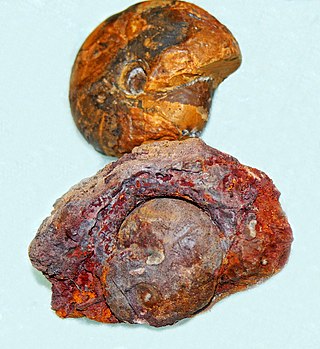
Ammonoids are a group of extinct marine mollusc animals in the subclass Ammonoidea of the class Cephalopoda. These molluscs, commonly referred to as ammonites, are more closely related to living coleoids than they are to shelled nautiloids such as the living Nautilus species. The earliest ammonites appeared during the Devonian, with the last species vanishing during or soon after the Cretaceous–Paleogene extinction event.
Alaoceras is an ammonoid cephalopod from the upper Paleozoic included in the goniatitid family Cravenoceratidae, named by Ruzhentsev & Bogoslovskaya in 1971.

Beyrichoceras is a genus belonging to the goniatitid family Maxigoniatitidae that lived during the Mississippian Period

Aturia is an extinct genus of Paleocene to Miocene nautilids within Aturiidae, a monotypic family, established by Campman in 1857 for Aturia Bronn, 1838, and is included in the superfamily Nautilaceae in Kümmel 1964.

Prolecanitida is an order of extinct ammonoid cephalopods, the major Late Paleozoic group of ammonoids alongside the order Goniatitida. Prolecanitids had narrow shells, discoidal (disc-shaped) to thinly lenticular (lens-shaped). They retained a retrochoanitic siphuncle, a simple form with septal necks extending backwards. As is typical for ammonoids, the siphuncle sits along the ventral margin of the shell.

Prolecanitoidea is a taxonomic superfamily of ammonoids in the order Prolecanitida. Prolecanitoidea is one of two superfamilies in the order, along with the younger and more complex Medlicottioidea. The Prolecanitoidea were a low-diversity and morphologically conservative group. They lived from the Lower Carboniferous up to the Middle Permian. Their shells are generally smooth and discoidal, with a rounded lower edge, a moderate to large umbilicus, and goniatitic to ceratitic sutures. Suture complexity varies from 10 up to 22 total lobes ; new lobes are added from subdivision of saddles adjacent to the original main umbilical lobe.
The Clydonautiloidea are a superfamily within the nautiloid order Nautilida characterized by smooth, generally globular, shells with nearly straight sutures, in early forms, but developing highly differentiated sutures in some later forms. Where known, the siphuncle tends to be central to subcentral.

Grypoceratidae is the longest-lived family of the Trigonoceratoidea, or of the near equivalent Centroceratina; members of the Nautilida from the Upper Paleozoic and Triassic.
The Centroceratidae is the ancestral family of the Trigonoceratoidea and of the equivalent Centroceratina; extinct shelled cephalopods belonging to the order Nautilida
Aphelaeceras is an extinct genus from the nautilid family Trigonoceratidae which is part of the Trigonocerataceae, that lived during the Mississippian Period in the late Paleozoic.
Gonionautilidae is a family in the nautilid superfamily Clydonautiliaceae that contains only the genus Gonionautilus, known from the Upper Triassic (Norian) of Europe and North America.
The Rhiphaeoceratidae are a small family of nautilids included in the superfamily Tainoceratoidea that comprises four very similar genera. These genera are characterized by a perforate umbilicus and little more than a single evolute coil. Whorl sections are oval, subquadrate, or subtrapezoidal. Sutures bend forward on the outer rim, forming wide shallow ventral saddles and dip strongly to the rear on the inner rim, forming deep dorsal lobes.
Edaphoceras is a genus of koninckioceratid nautilids from the Mississippian of North America, named by Hyatt, 1884, with depressed whorls just in contact. The shell, as typical for the family, is evolute; whorl section is fusiform with broadly rounded venter and dorsum meeting at a narrow angle on either side. Its suture has a distinct ventral and dorsal lobe and an angular lateral saddle. The siphuncle is small and near central.
Lophoceras is a genus of Nautilids belonging to the tainoceratoidean family, Koninckioceratidae, found in Lower Carboniferous sediments in Europe, and named by Hyatt, 1893. The shell of Lophoceras is evolute, large, with a slight impressed zone on the inner rim. In early volutions whorl sections are rounded, but later develop an obtusely angular ventral area and venter that disappears toward the front of the mature body chamber. The suture has an angular ventral saddle, broad shallow lateral lobe, and a dorsal lobe. Except for growth line, the shell is smooth.
Pseudonautilidae is a family of Jurassic and Lower Cretaceous nautilid cephalopods belonging to the same superfamily as modern Nautilus, Nautilaceae, but forming a different branch from the family Nautilidae. Pseudonautilids, together with other nautilids, were contemporary with the ammonoids, which comprise an entirely different set of shelled cephalopod stocks more closely related to octopus and squid.
The Uddenitinae a subfamily of the Medlicottiidae, a family of ammonoid cephalopods included in the Prolecanitida. The Uddenitinae, proposed by Miller and Furnish, and known from the Pennsylvanian and Lower Permian, are transitional between the ancestral Pronoritidae and the more traditional medlicottiids
Clydonautilus is a genus of nautiloids and type for the Clydonautilidae that has been found in the Upper Triassic of Europe, India, and Timor. Its type is C. noricus.
Proclydonautilus is a genus of nautiloids belonging to the Clydonautilidae known from the Upper Triassic of North America, Europe, and India.
Styrionautilus is a genus of nautiloids and first of the Clydonautilidae with a range extending from the Middle Triassic, Anisian to the Upper Triassic, Norian. Its fossils have been found in North America (Nevada), Europe, and Timor.
Aulacaganides is monospecific genus of a Middle Permian ammonite belonging to the goniatitid family Pseudohaloritidae. Fossils belonging to this genera were found in Hunan province of China.




